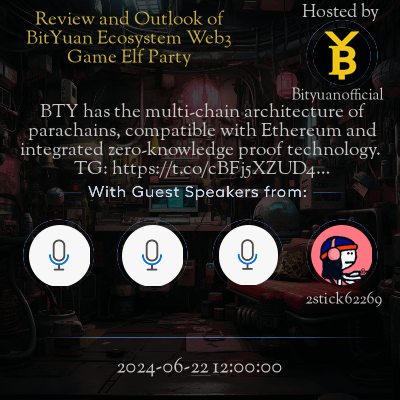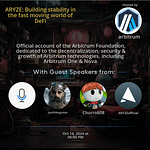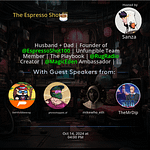This space is hosted by Bityuanofficial
Space Summary
In this engaging discussion, participants delved deep into the implications of Elon Musk’s acquisition of Twitter, particularly focusing on the contested nature of free speech on social media platforms. They debated whether true freedom of expression is possible and examined the complexities AI algorithms face in moderating contextual content. Historical parallels were drawn between past global conflicts and current societal frameworks, sparking conversations on whether we are in the midst of ‘World War Three.’ Ethical issues surrounding online speech moderation sparked insightful debates, with participants sharing personal experiences of content silencing. This session encapsulated diverse viewpoints, particularly from the youth, on public figures and celebrities’ influence. Ultimately, it highlighted that while AI and algorithms hold promise for managing social platforms, they also encounter significant challenges that must be addressed moving forward.
Questions
Q: How has Elon Musk’s acquisition affected Twitter?
A: It has significant implications, particularly around free speech and platform policies.
Q: Can we truly have free speech on Twitter?
A: Not entirely; various opinions indicated moderation and silencing of certain content.
Q: What challenges do AI algorithms face on Twitter?
A: Context differentiation remains a major challenge.
Q: How do historical global conflicts relate to current societal structures?
A: Discussions connected the global control mechanisms established post-WWII to modern issues.
Q: How is youth culture influenced by public figures?
A: There are diverse opinions, reflecting admiration and criticism of celebrity behaviors.
Q: What ethical issues arise from moderating free speech online?
A: Balancing harmful content and free expression is complex and contentious.
Q: Why do people think we’re in ‘World War Three’?
A: Multiple viewpoints, mostly rooted in broader societal and political dynamics rather than outright conflict.
Q: Can social media platforms handle the nuances of public commentary?
A: Not fully, as current systems struggle with subtlety and intent.
Q: Are there specific examples of controversial moderation?
A: Yes, users shared personal stories of being warned or silenced for seemingly benign comments.
Q: What future for AI in managing social platforms?
A: It remains uncertain, with potential but also significant hurdles to effective moderation.
Highlights
Time: 00:00:14
Discussion on Free Speech
Time: 00:05:30
Moderation Problems
Time: 00:10:45
Global Conflict Comparisons
Time: 00:15:20
Youth Perspectives
Time: 00:20:17
Ethical Issues in Moderation
Time: 00:25:40
Historical Lenses
Time: 00:30:35
Examples of Content Silencing
Time: 00:35:50
AI’s Future Impact
Time: 00:40:00
Definition of World War Three
Time: 00:45:30
Algorithm Limitations
Time: 00:50:15
Public Commentary Nuances
Key Takeaways
- Elon Musk’s acquisition of Twitter has significant implications for the platform’s future.
- The issue of free speech on social media remains multifaceted and contested.
- AI systems struggle to effectively moderate content due to difficulties in contextual understanding.
- Historical global conflict comparisons were made to analyze modern societal structures and tensions.
- Diverse interpretations of historical events like World War were discussed
- reflecting varying perspectives.
- Youth perspectives on public figures showcased a mix of admiration and criticism.
- Ethical dilemmas surrounding online speech moderation were debated
- highlighting the complexities involved.
- Historical lenses were used to examine contemporary societal control mechanisms.
- Challenges in moderating public sentiment and comments were explored.
- Discussions also focused on the potential and limitations of AI and algorithms in social spaces.
Behind the Mic
Hello? Hello? I can hear you. Okay. Hello, everyone. I’m the host, Kelsey. I’m very happy that you have come to participate in this AMA event. Today I’m discussing with Jason, the consultant expert from the BTM foundation. Now, please let Jason introduce himself. Let’s welcome Jason. Hello, everyone. Thank you, Kasly. This is Jason from B two M foundation. Nice to see you again, my friends. And I’m really excited to be here at Xbase to interact with all of you today. Thank you. Thank you. Jason, we have some questions prepared for you today. Hope you guys would love it. And let’s start with the first question. There is a web three game f party on the BTM production, which is very popular recently. Could you please give a brief introduction to this game? Okay, for those of you who have experienced the elf party game, you can feel that this is a low barrier web three game that everyone can participate in. The game consists of two parts. One is to play and pass the levels of the game, and the other is to mine, Bty by L. It’s a game on the Bitw blockchain. And sure, it’s settled in. Bty. Frankly, this is the first game based on the BitVM blockchain, which has been developed and tested for several months, and we are very grateful for everyone’s active participation and support. Bit BDPY has already been listed on Airbank Exchange and the users can easily sell Bty for USDT in lbank. Thank you. Great. There are many blockchain games in the industry. To attract customers, they need to have unique features. What are the features of the blockchain game? App party. As you have mentioned, a game needs to have its unique feature to attract players, and blockchain games, or we say Gamefi are no exception. So what attracts players the most in blockchain games compared to traditional games is the token economy where players can earn tokens by playing. This is the most typical character of blockchain games at the moment. And of course, the advantages of blockchain games over traditional games will also be reflected in our party. With the rise of NFTS and dows, players not only play games but also participate in the governance and relevant incentives of the game. It is these features that make the Elf Party very attractive. Meanwhile, we have added the collaborate mod to encourage players’ collaboration. By doing so, we hope that Elf Party is not only a game for pure play but also an web three game that can promote collaboration and provide more benefits. And Elf Party has done a fantastic job in this area. Could you tell us about the token and economic models of Elf Party and how do players earn money through this game? In terms of the income model of our party, actually there are many ways to earn tokens in the app party. However, the most important part is how players earn Bty. Firstly, players can obtain mystery boxes and tokens by consuming energy and letter levels. Secondly, players can also profit by trading game props in equipment. Thank you very much. Jason. Let’s move to the next question. The concept of web three gaming has been admired by the major game vendors at home and abroad in the past year, and endless attempts have been made. Could you please introduce the current status of the Elf Party and web three gaming industry? Yeah, after more than a decade of predictions and speculations, it looks like mainstream blockchain games may finally be coming to fruition. And it’s already here. This is a good news for the whole industry. It’s showing us that people want to try something new and they like it. From late 2021 to early 2022, when Gamefi came out in full force, almost every day we saw new projects, new roads, and new investors popping up, and the market grew quickly to a level we hadn’t seen before. As you just mentioned, Elf Party is one of the most representative projects in the web three gaming space. For example, it first combines Gamefi with the IAM concept. At the same time, it also has a very low entry point, which virtually makes everyone a participant. And I believe the Elf Party will become a very strong booster in propelling the popularity of web three and Gamefi. Meanwhile, other web three blockchain games are also in full swing development, like Big Time and the Beacon of other Empires. Robot era. Thanks. Please introduce the advantages and disadvantages of Web three games. And what’s the next step of Elf Party? Based on my experience, the benefits we can expect from web three games are quite exciting. First is digital ownership. With NFTS and tokens, players truly own their in-game assets. This ownership opens up new possibilities for trading and transferring items outside of the game. Second is transparence and trust. Blockchain technology ensures fairness and trustworthiness, reducing issues like cheating or fraud. Players can see transactions on the blockchain, making the whole process more transparent. Third is economic opportunities. Play to earn. We’ve all heard of it. And now it’s play and earn gives players chances to make an actual income from their gaming activities, which is revolutionizing the way people interact with games. And lastly, interoperability. Imagine a scenario where you could use items or characters from one game and another. Of course, there are disadvantages, too. Let me briefly mention it. The first serious problem facing web three games is high entry barrier. While embracing blockchain technology, some games still have high entry requirements that can discourage the new players. The next issue is volatile token economy. The value of in-game tokens can be very unpredictable, which could either make you reach overnight or lead to a total loss depending on market situation. And the third is regulatory uncertainty. Many regions are still figuring out how to regulate blockchain games, and unclear regulations can make it difficult for developers to operate legally. And we firstly and crucially need to focus on these key aspects in the next step of Elf Party development. One is more user friendly, simplifying the onboarding process for new players by making the game more user friendly and accessible. The second is stabilizing the token economy. Implementing mechanisms to stabilize the value of in-game tokens to provide a sustainable economic model for players. Third is secure regulatory hurts. Keep an eye on and adopte with the regulatory changes to make sure Elf Party stays compliant with laws and regulations around the world. By addressing these points, Elf Party can continue to develop and maintain its position as a leader in the Web three gaming space. The next question is, as we mentioned earlier, the entry requirements for many of the current Augustweb three games are too high. Do you think those comers can be interested in Elf Party or its. Yes, you’re right. The high entry barrier should be and must be paid attention to in the web three games. Looking at Elf Party, we aim to be very novice friendly. First off the bat, it’s easy to start with no significant initial investment required. This is appealing to newcomers. Second aspect is the social elements within the game. It attracts a broad audience. Collaboration and competition within a positive community makes the game more enjoyable. Lastly, the reward system is designed to make newcomers feel valued and encouraged. Even if they don’t have the expensive NFC assets, they can still play part and earn rewards. All of these elements together make Elf Party a very user friendly game that draws interest from a wide range of players. Thank you. Now let’s turn to another topic, blockchain games. Play to earn and earn a very hot topic, especially in the past year or so. and many players have made money from games. And of course, some may have lost money. How do you think play to earn model will develop in the future? As we can see, the extremely high returns of play to earn have attracted a large number of users into the market. However, only relying on this incentive to retain players has been proven to be a rather unsustainable model. Thus, a new concept, play and earn was born as a remedy. Play and earn emphasizes more on the fun of the game. The reward is seen as an auxiliary part, which refocuses on the inherent joy of gaming while still maintaining economic incentives. This shift promotes a more balance and sustainable game economy, which defens player engagement besides this. We expect that play and earn will integrate more closely with dows and nft to further promote players involvement in the governance and economic model of the games in the future. Players won’t just be users anymore. They become a part of the decision making process through doubts and can experience more diversified income models through NFTS. It’s like being a shareholder, but in a game, and you can earn from the game’s growth or profits. Games might let you hold tokens that give you a say in a daw. You can influence where the game is headed and get rewards or dividends for being part of it. And the impact of this shift is pretty clear, and it is happening fast. The first is it has wider audience. Play and earn can attract all kinds of players, not just the game players, those who are into being part of a community and help to steal the game’s direction. The second is sustainable growth with community and governance involvement. Games can adapt better to what players want and how the market is changing, making for a longer, healthier life of the game. The third is increase the player loyalty. Offering governance and community involvement can make players feel more connected and loyal to the game. It’s quite important for the growth and the development of any game. And fourth is diverse economic models. Play and earn encourages game developers to think outside the box and come up with a variety of ways for players to earn and engage with the game. Finally, the move from play to earn to play and earn shows that the blockchain game, or we can say game five, values player involvement and community building. It is all about innovating how the game economic works, which is good for the health of the industry and gives players a richer experience and more chances to earn. I’m really looking forward to this shift and believe Gamefi would give us a big surprise in the short future. That’s it. Thank you. Thank you for your answer. It’s a really big topic. Believe that whether it is play to earn or play and earn model the web three gaming field will develop in a healthier direction and the industry will become more mature in the future. And now the session is ended. We are very glad to have you guys in this session. Please look forward to our AMA next week. Relevant information will be released soon. Thank you. Bye bye. Thank you. See you next week everybody. See you.







